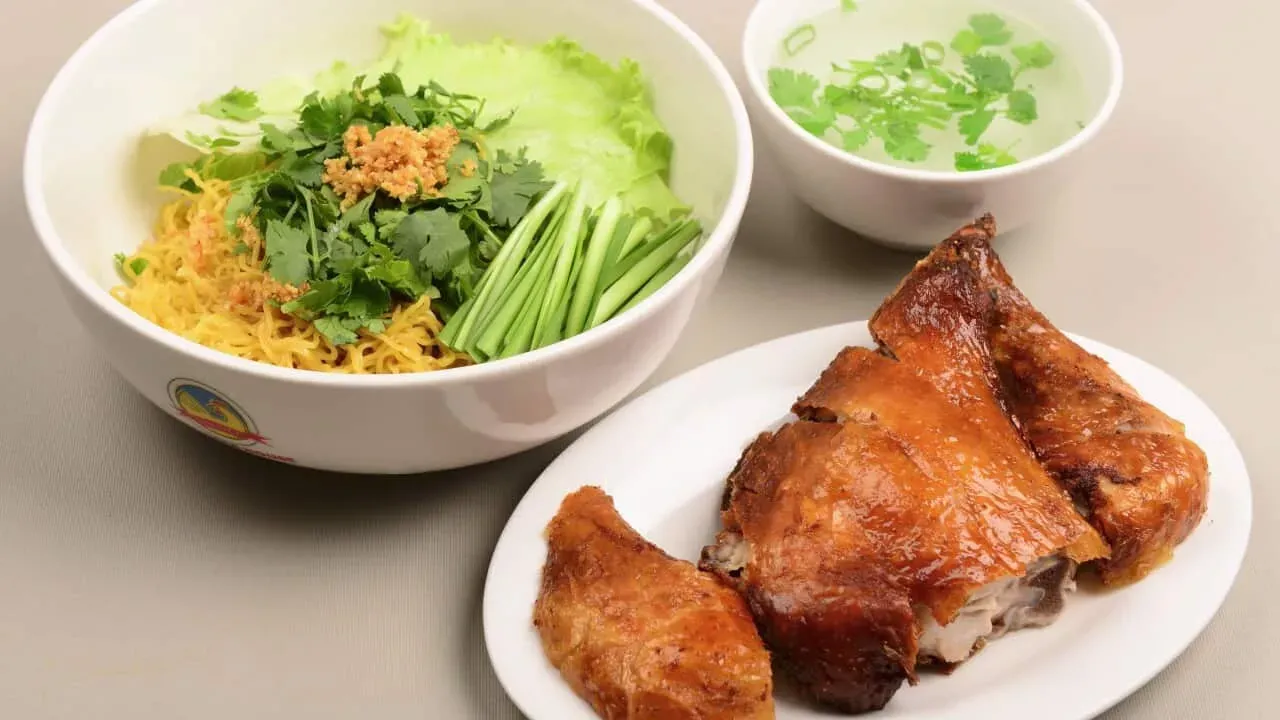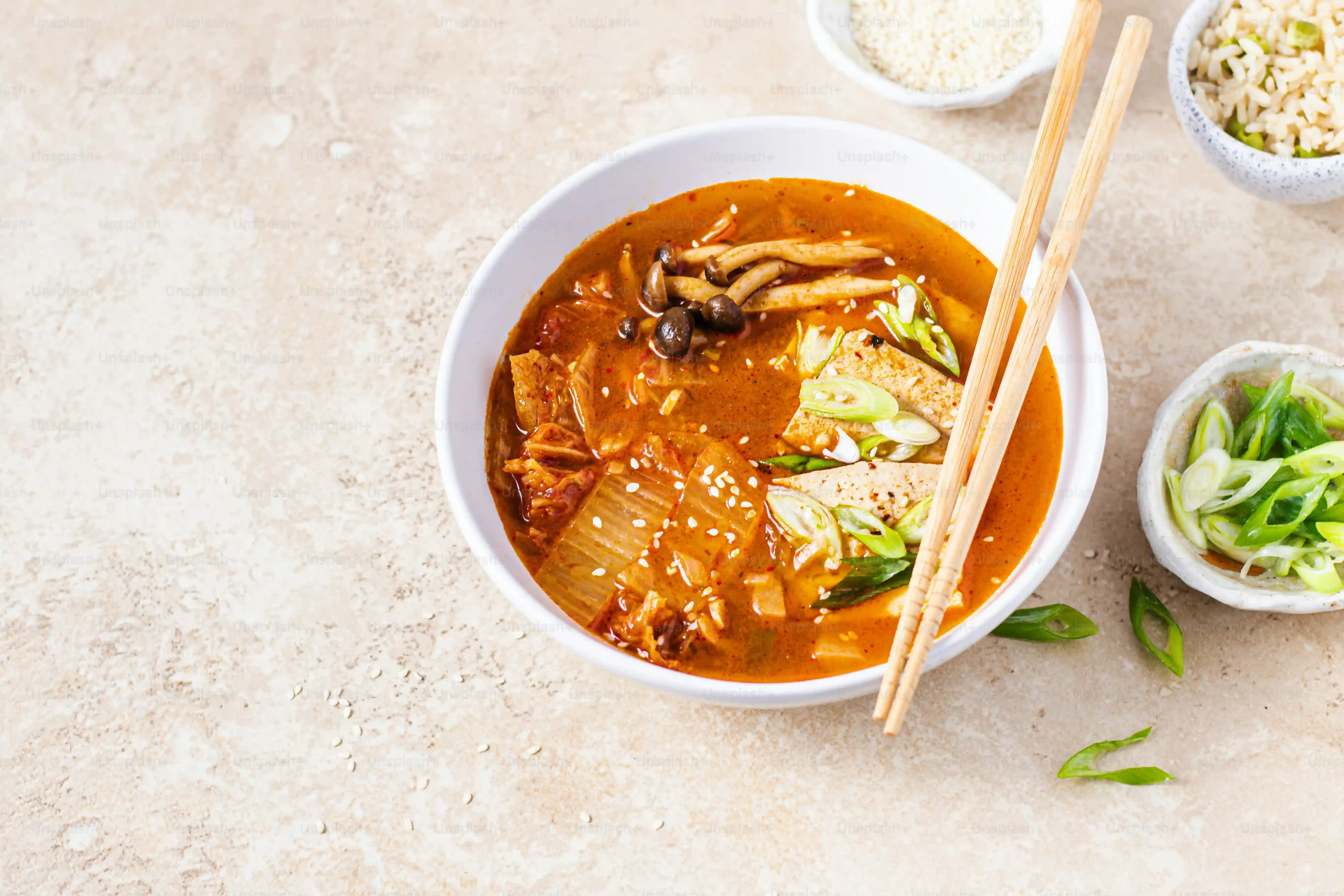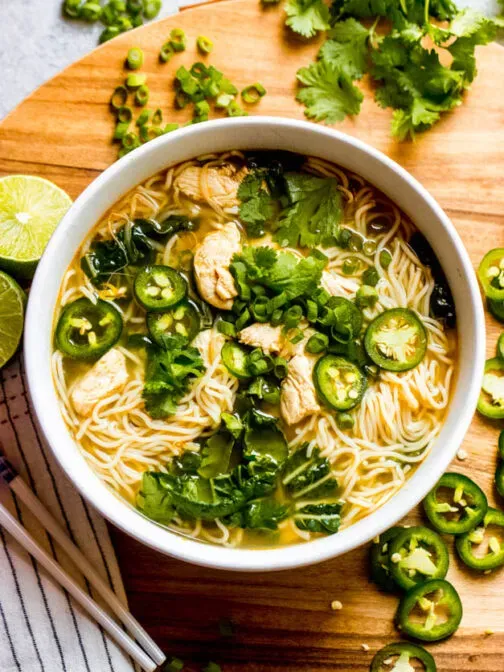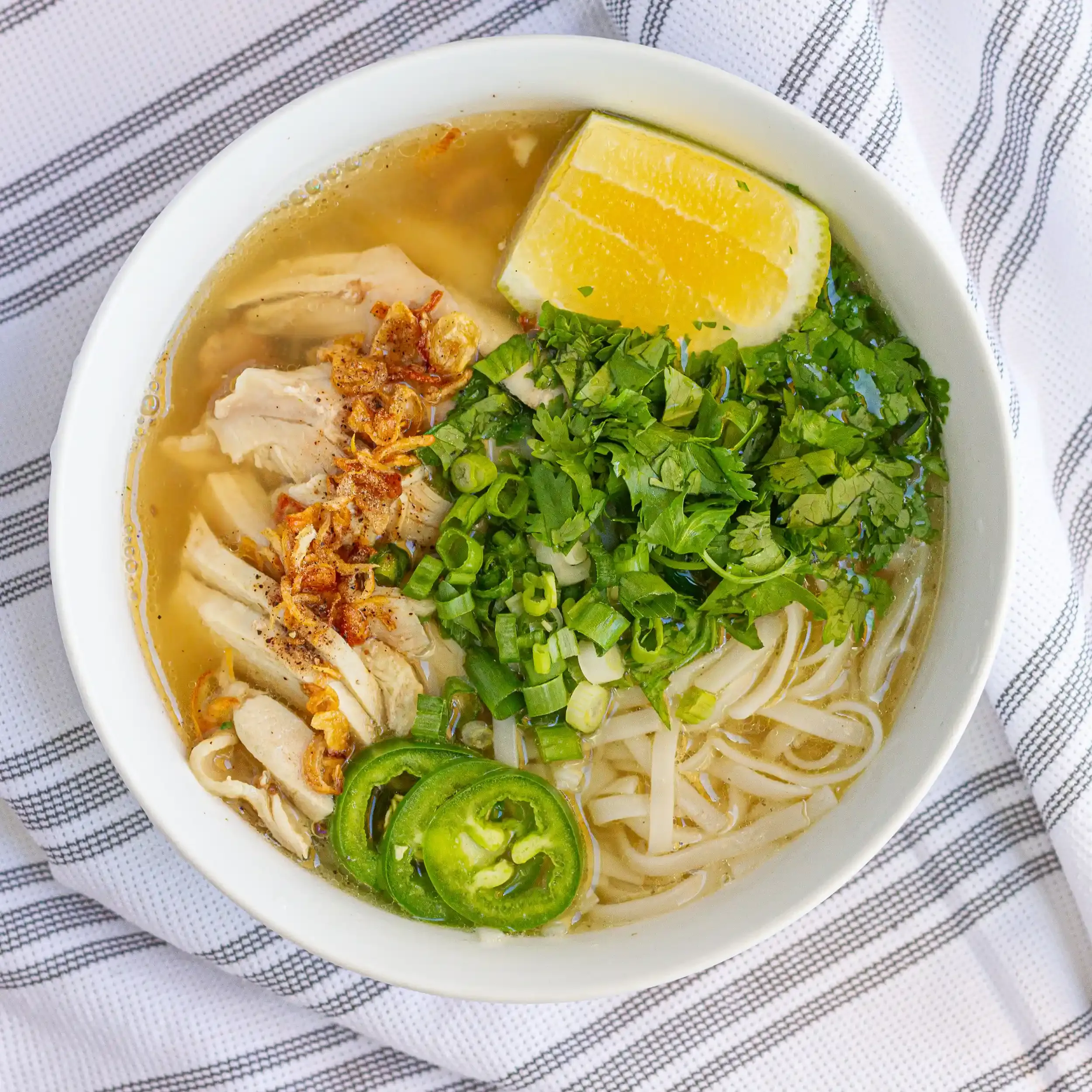Table of Contents
Craving that perfect bowl of Vietnamese crispy skin chicken noodle soup? You know the one – where the chicken skin crackles just right, the meat stays juicy, and the broth sings with layers of flavor. It’s a dish that hits all the right notes: comforting, complex, and utterly satisfying. Many folks try to make this at home, only to end up with soggy skin or a bland broth. It's not rocket science, but it does require paying attention to a few key details.
Mastering the Crispy Skin Chicken

Mastering the Crispy Skin Chicken
The Essential First Step: Drying the Skin
Alright, let's talk crispy skin. This isn't something that happens by accident; it's a deliberate act of culinary will. The single most crucial step in achieving that shatteringly crisp skin for your vietnamese crispy skin chicken noodle soup recipe is drying it out. Seriously, you need to get every drop of moisture off that skin. Think of water as the enemy of crispness. Pat it down relentlessly with paper towels. Some folks even let the chicken air dry in the fridge, uncovered, overnight. This allows the skin to become almost leathery, which is exactly what you want before it hits the heat.
Don't skip this part. A damp chicken skin will steam rather than crisp, leaving you with something rubbery and disappointing. We're aiming for crackling bliss here, not chewiness. Pat, pat, pat until you think you can't pat anymore, then pat some more. This foundation is everything.
The Two-Phase Cooking Technique
Getting the skin crispy while keeping the meat moist feels like a magic trick, but it's just smart cooking. The secret lies in a two-phase approach. First, you gently cook the chicken through without directly exposing the skin to high heat. Poaching or steaming the chicken is the classic method. This ensures the meat is cooked, tender, and juicy on the inside.
Once the chicken is cooked through, you move to phase two: crisping the skin. This is where you apply direct, high heat. This method guarantees you don't overcook the meat while you focus solely on rendering the fat and crisping the skin to perfection. It's a controlled approach that delivers on both texture and tenderness.
- Pat chicken skin bone dry with paper towels.
- Optionally, air dry in the fridge overnight for maximum effect.
- Gently poach or steam chicken until cooked through.
- Cool chicken slightly before crisping the skin.
- Apply high heat (frying or roasting) solely to the skin.
Achieving Golden, Crackling Perfection
With the chicken cooked and the skin dry, it's time for the grand finale. Frying is perhaps the most traditional way to get that intense crispiness. You need oil hot enough to instantly start rendering the fat under the skin, but not so hot it burns before it crisps. Carefully lower the chicken, skin-side down, into the hot oil. You'll hear that glorious sizzle immediately.
Alternatively, you can roast the chicken, skin-side up, at a high temperature. Brush the skin with a little oil first. Keep an eye on it; it can go from perfectly golden to charred in moments. The goal is a beautiful, deep golden-brown color and a skin that shatters when you tap it. This is the payoff for all that careful preparation – the star component of your vietnamese crispy skin chicken noodle soup recipe.
Building the Flavorful Noodle Soup Broth

Building the Flavorful Noodle Soup Broth
Starting with a Solid Foundation
let's get serious about this broth. It's the soul of your vietnamese crispy skin chicken noodle soup recipe. You can't just boil some water and throw in a bouillon cube and expect magic. A great broth starts with bones – chicken bones are obvious here, maybe some backs and wings for collagen. You need to give them a quick blanch first. This gets rid of all the nasty impurities that can make your broth cloudy and taste... well, not great. Just a few minutes in boiling water, then drain and rinse them clean. This step seems minor, but it makes a world of difference to the clarity and purity of your final broth.
Layering the Aromatics and Spices
Once your bones are prepped, it's time to build flavor. This is where the Vietnamese magic happens. You're going to need star anise, cinnamon sticks, black cardamom pods (if you can find them), cloves, and coriander seeds. Don't just toss them in raw. Toast these spices gently in a dry pan until they smell fragrant. This wakes them up and releases their essential oils. Charring ginger and onions or shallots is also non-negotiable. Slice them thick and lay them directly on a dry pan or under a broiler until they get dark spots and smell smoky. This caramelizes the sugars and adds a depth you won't get otherwise.
These charred aromatics and toasted spices go into the pot with your blanched bones. Add enough cold water to cover everything generously. Cold water helps extract more flavor from the bones as it slowly heats up. Throw in a piece of rock sugar for a touch of sweetness that balances the savory notes – it’s traditional and important. A splash of fish sauce goes in early too; it provides that essential umami backbone without making the broth taste overtly fishy.
- Blanch chicken bones to remove impurities.
- Toast star anise, cinnamon, cardamom, cloves, coriander seeds.
- Char ginger and onions/shallots until smoky.
- Combine bones, toasted spices, and charred aromatics in a pot.
- Add cold water and rock sugar.
- Include a splash of quality fish sauce.
The Gentle Simmer and Seasoning
Now, bring the pot to a gentle simmer. And I mean gentle. You don't want a rolling boil; that will make your broth cloudy and can break down the flavors. A lazy bubble is perfect. Skim off any foam or scum that rises to the surface as it simmers; this keeps your broth clean and bright. Let it simmer for at least an hour, preferably longer, two or three if you have the time. The longer it simmers gently, the more flavor you pull from the bones and aromatics.
Towards the end of the simmering time, you'll need to taste and adjust. This is crucial. Add more fish sauce if it needs more savory depth. A pinch of salt might be necessary. The broth should taste complex, aromatic, and balanced. Remember, you're building the core flavor for your entire vietnamese crispy skin chicken noodle soup recipe here. Don't rush this final seasoning step.
Cooking the Noodles and Preparing Toppings

Cooking the Noodles and Preparing Toppings
Getting the Noodles Right
noodles are not just filler; they're the vehicle for all that glorious broth and crispy chicken. For Vietnamese chicken noodle soup, or Pho Ga, you're typically looking for flat rice noodles. Fresh is always better if you can find them, but dried works perfectly fine too. The trick here is not to overcook them. Soggy noodles are a culinary crime. You want them al dente, with a slight chew.
Bring a pot of water to a rolling boil. Add the noodles and cook them according to the package directions, but start checking them a minute or two before the suggested time. They cook fast, especially the dried ones. Drain them immediately and rinse them briefly with warm water. This prevents them from sticking together and stops the cooking process. Don't rinse with cold water; that cools them down too much before they hit the hot broth.
Prepping the Essential Toppings
The toppings are non-negotiable; they add freshness, texture, and vital flavor layers to your vietnamese crispy skin chicken noodle soup recipe. Bean sprouts provide crunch, fresh herbs like Thai basil, mint, and cilantro bring fragrance, and sliced chilies (like bird's eye) offer heat for those who dare. Thinly sliced white onion or shallots add a sharp bite that cuts through the richness.
Prep all of these ahead of time. Wash the herbs and sprouts thoroughly. Pick the herb leaves from the stems. Slice the onions paper-thin – seriously thin. If you're using lime, cut it into wedges. Having everything ready to go means you can assemble your bowl quickly while the broth is piping hot and the chicken is still warm.
- Flat rice noodles (fresh or dried)
- Fresh bean sprouts
- Thai basil
- Mint
- Cilantro
- Thinly sliced white onion or shallots
- Sliced chilies (optional)
- Lime wedges
Adding Those Finishing Touches
Beyond the absolute essentials, there are other elements that elevate your bowl. Green onions, thinly sliced diagonally, add a mild onion flavor and a pop of color. A sprinkle of black pepper just before serving is classic. Some people like a drizzle of chili oil for extra heat and a rich, smoky flavor. Don't underestimate the power of these small additions; they contribute significantly to the overall complexity of your vietnamese crispy skin chicken noodle soup recipe.
Assembling and Serving Your Vietnamese Crispy Skin Chicken Noodle Soup

Assembling and Serving Your Vietnamese Crispy Skin Chicken Noodle Soup
Putting It All Together
you've got the crispy chicken ready, the broth is simmering beautifully, and your noodles and toppings are prepped. Now comes the moment of truth: assembling your bowl of Vietnamese crispy skin chicken noodle soup. This isn't just dumping stuff in; it's about layering the ingredients so each spoonful delivers a balanced bite. Start with the cooked rice noodles in the bottom of a deep bowl. Arrange slices of that glorious crispy skin chicken over the noodles. Pile on a generous handful of fresh bean sprouts and those thinly sliced onions or shallots. Ladle the piping hot broth over everything. The heat of the broth will slightly cook the bean sprouts and release the aromatics from the onions. Garnish with a scattering of fresh herbs – basil, mint, cilantro – and maybe those green onions. Add a lime wedge on the side for squeezing and chilies if you like the heat. Don't drown the bowl in broth; you want enough to cover the noodles and chicken but still see the toppings.
- Place cooked noodles in bowl.
- Top with sliced crispy chicken.
- Add bean sprouts and sliced onions/shallots.
- Ladle hot broth over ingredients.
- Garnish with fresh herbs and green onions.
- Serve with lime wedges and chilies on the side.
Tips and Tricks for Success

Tips and Tricks for Success
Don't Be Shy with the Broth Seasoning
Look, making the broth is where many people stumble with their vietnamese crispy skin chicken noodle soup recipe. They follow the steps, add the spices, simmer away, and then they taste it, and it's... fine. Just fine isn't good enough. Your broth needs to taste vibrant and complex on its own, almost *too* strong before it hits the noodles and toppings. Why? Because the noodles absorb flavor, and the fresh herbs and sprouts dilute it slightly. If your broth tastes perfectly balanced in the pot, it will taste bland in the bowl.
So, taste it. Does it need more fish sauce for that umami punch? A tiny bit more rock sugar to round things out? Don't be afraid to adjust. This is the core of the dish. A timidly seasoned broth results in a timid soup, and nobody wants that after all the effort you put into that crispy chicken.
Timing is Everything for Noodles and Assembly
You've nailed the crispy chicken, the broth is a masterpiece, now don't mess it up at the finish line. Overcooked noodles are a tragedy, turning your beautiful dish into a mushy disappointment. Cook them just before you're ready to serve, and cook them al dente. They'll continue to cook slightly in the hot broth.
Equally important is having all your toppings prepped and ready *before* you even think about ladling broth. Once that hot liquid hits the bowl, things move fast. You want to assemble quickly and get it to the table while everything is at its peak temperature and texture. A cold noodle or a wilted herb because you were still chopping onions just won't cut it for your perfect vietnamese crispy skin chicken noodle soup recipe.
- Taste and adjust broth seasoning aggressively; it should be potent.
- Cook noodles just before serving and aim for al dente.
- Prep all toppings (herbs, sprouts, onions, lime, chilies) in advance.
- Assemble bowls quickly once broth is hot.
- Don't overcrowd the bowl; layer for best results.
FAQs About Vietnamese Crispy Skin Chicken Noodle Soup

FAQs About Vietnamese Crispy Skin Chicken Noodle Soup
Why isn't my chicken skin crispy?
let's cut to the chase. If your chicken skin came out flabby instead of that glorious crackle, you probably skipped or rushed the drying step. Remember how we talked about patting it bone dry? That's non-negotiable. Any moisture on the skin turns into steam when it hits heat, and steam is the enemy of crispness. Also, make sure your oil or oven is hot enough when you do the final crisping phase. If the temperature is too low, the skin just sits there and gets greasy instead of rendering its fat and turning golden. It's like trying to tan in cloudy weather – just doesn't work.
My broth tastes… flat. What went wrong?
Ah, the bland broth blues. You followed the steps, added the spices, but it just lacks that oomph, right? This is a common pitfall in making vietnamese crispy skin chicken noodle soup recipe. Two main culprits here: not enough simmering time or timid seasoning. Did you really let it simmer gently for at least an hour, preferably longer? The longer it goes, the more flavor you pull from the bones and aromatics. Second, did you taste and adjust the seasoning aggressively? Your broth needs to taste quite strong on its own because the noodles and toppings will dilute it in the bowl. Don't be shy with the fish sauce; it's the backbone of the flavor. A little more rock sugar can also balance things out without making it sweet.
Here are some common broth fixes:
- Simmer longer on low heat.
- Add more fish sauce, tasting as you go.
- Try a small pinch of salt.
- Ensure your spices were toasted and aromatics charred properly.
- Make sure you skimmed off impurities for a clean flavor.
Can I make parts of the soup ahead of time?
Absolutely, and honestly, it makes serving way less stressful. The broth is perfect for making in advance. Simmer it, strain it, let it cool completely, then store it in the fridge for up to 3-4 days or freeze it. The crispy chicken can also be made ahead, but the skin is best eaten fresh. If you must make it ahead, cook the chicken, let it cool, and store it. Reheat it in a hot oven or air fryer to re-crisp the skin just before serving. Don't microwave it unless you enjoy rubber. Prep all your toppings – washing herbs, slicing onions, getting sprouts ready – hours before you plan to assemble. This way, when it's time to eat, all you need to do is reheat the broth, cook the noodles quickly, re-crisp the chicken if needed, and assemble your perfect bowl of vietnamese crispy skin chicken noodle soup.
Wrapping It Up: Your Crispy Success
So there you have it. You've navigated the tricky world of achieving that elusive crispy skin and built a broth that actually tastes like something. It wasn't just dumping ingredients in a pot and hoping for the best, was it? Making a proper vietnamese crispy skin chicken noodle soup recipe takes a bit of effort, sure, but the result is a million miles away from those sad, watery versions you might have encountered. You've got the tools now. Go forth and make crispy, flavorful soup. Your kitchen (and your stomach) will thank you.
